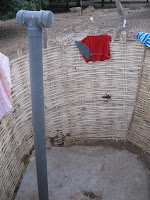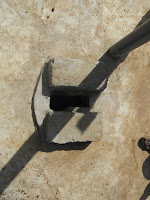I've posted about cervical cancer and Peace Corps' partnership with PeaceCare, a Chicago-based non-governmental organization, several times over the last couple years. It's been a productive and really interesting collaboration, and if you like you're welcome to read (or maybe re-read) about it
here and
and here and
and here, too.
Over the last few visits Peace Corps Volunteers (currently myself,
Marielle,
Annē and
Chip) worked with the PeaceCare team to increase awareness and understanding of cervical cancer, identify and collaborate with Senegalese cervical cancer specialists, and train local midwives and doctors to perform Visual Inspection with Acetic acid (VIA) to identify pre-cancerous lesions on the cervix. Acetic acid is just vinegar, and pre-cancerous cells are acidophilic, so they soak up acidic things and change color, making them easy to identify visually.
 |
| Chip with pause cafe snacks |
 |
| Marielle with the cryo tank and gun |
Once a pre-cancerous lesion has been diagnosed it can be treated with cryotherapy (using special equipment to freeze the lesion) to prevent it from becoming cancerous. This time around the team's goal was to get cryotherapy equipment up and running and to train several local health workers how and when to use it to treat patients. The trainees (one doctor and two midwives) did really well with the theory and practice on models, and were able to observe and practice a couple actual cryotherapy treatments.
 |
| Cryo tank and gun |
 |
Tracy, the PeaceCare team's fantastic
OB-Gyn, leading a training session |
Unfortunately, there weren't enough women who came in with pre-cancerous lesions to allow the trainees to practice using the equipment an adequate number of times be certified as qualified cryotherapy treatment providers during the team's visit. Fortunately, a gynecologist who does cryotherapy in Tamba agreed to host at least one of the trainees and supervise the cryotherapy sessions until they have had enough practice to be officially certified, which is fantastic. The treatment basically involves putting a special tip on the cryo gun and applying the tip to the cervix for a three-minute freezing cycle, removing it for a five-minute thaw cycle, and then repeating the process once. It's neither painful nor technically difficult, doesn't require electricity or a sterile operating room, and it's quite effective at destroying abnormal cells.
As great as cryotherapy is, the trip, as
PCV Patrick Hair would say, "wasn't all Skittles." There were delays and stomach rumblings and scheduling debacles, but the team persevered and made a lot of progress. For me, the most significant moment came at the end of the last day of the cryotherapy training, when a woman who had been diagnosed with a pre-cancerous lesion during a screening in December 2012 came in and asked to be seen.
The trainee team (midwives Oulli and Diouma, and Dr Kabou) counselled her, explaining that they would re-check the VIA results and went over the benefits and risks of cryotherapy, and she consented enthusiastically. (I was in the room to translate for Tracy, who was guiding and supervising the midwives.) They told the patient that it might be a little uncomfortable and she replied the she didn't care if it hurt a lot if it got rid of the illness. Everything went smoothly, and during the treatment procedure the patient said it felt cold and slightly uncomfortable but not painful.
Immediately after the procedure after she was up and about and really, really, really pleased. In rapid Pulaar (I was totally proud of myself for keeping up) she thanked the team profusely and explained that when she got diagnosed with an illness she had been very worried. She said that hospital stays are expensive, the nearest gynecologist is far away in Tamba, and if you don't have your health you don't have anything. She had completed secondary school and she understood the importance of health, that it's everything and you must care for it. She said it is so terrible to be told that you have an illness in your body, but that she was so happy that the team came to Kedougou and she was able to get treated. She thanked the trainees, Tracy, and myself, again and again, and then left, waving and smiling to the rest of the team on her way out of the hospital.
Her happiness and gratitude was both irrepressible and contagious, and everyone - the trainees, the PeaceCare team, the PCVs - ended the day and the Kedougou training on a wonderfully high note.










































